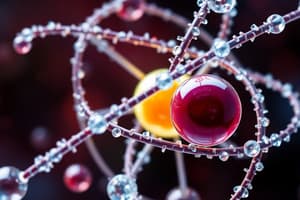Podcast
Questions and Answers
What component of an atom determines the atomic number?
What component of an atom determines the atomic number?
- Electrons
- Protons (correct)
- Neutrons
- Photons
Which subatomic particle influences an atom's mass and stability?
Which subatomic particle influences an atom's mass and stability?
- Photons
- Protons
- Neutrons (correct)
- Electrons
What are transitions between energy levels within an atom responsible for?
What are transitions between energy levels within an atom responsible for?
- Absorption of water
- Formation of chemical bonds
- Emission and absorption of light (correct)
- Production of sound waves
Which tools are used by scientists to investigate atomic structure?
Which tools are used by scientists to investigate atomic structure?
What has a profound impact on modern science, technology, and daily lives, according to the text?
What has a profound impact on modern science, technology, and daily lives, according to the text?
Study Notes
Unraveling Subatomic Particles: A Peek Inside Atomic Structure
The intricate dance of subatomic particles within atoms forms the backbone of our understanding of matter and the universe. As we delve into the intricacies of atomic structure, it's essential to explore the role of these fundamental building blocks, which include:
-
Electrons: Negatively charged, these particles orbit the nucleus of the atom, determining its chemical properties and atomic size.
-
Protons: Positively charged and located in the nucleus, protons contribute to an atom's atomic number, which in turn dictates its chemical behavior.
-
Neutrons: Uncharged particles found in the nucleus, neutrons influence an atom's mass and stability.
Discovering the Nucleus
In the early 20th century, scientists like Ernest Rutherford, Henry Moseley, and Niels Bohr, revolutionized our understanding of atomic structure, uncovering the nucleus and its constituent parts. Rutherford's famous gold foil experiment showed the presence of an extremely small, dense, positively charged center, leading to the notion of the nucleus. Moseley's work demonstrated that the frequency of X-rays emitted by atoms correlated with the atomic number, indicating that the nucleus contained a charge equal to the atomic number.
The Electronic Structure of Atoms
The arrangement of electrons around the nucleus, their interactions with each other, and their energy levels are described by the electronic structure of an atom. This structure defines an atom's chemical and physical properties, such as reactivity and stability.
The Nuclear Structure of Atoms
The nucleus, composed of protons and neutrons, holds the majority of an atom's mass. The number of protons determines the atomic number, which, in turn, dictates the element's chemical properties. The number of neutrons influences the atom's mass and stability.
Radiative Processes and Atomic Spectra
The study of atomic structure and radiative processes, focusing on the interactions between electrons and photons, is crucial to understanding the behavior of atoms. Transitions between energy levels result in the emission and absorption of light, collectively known as atomic spectra.
Modern Tools for Studying Atomic Structure
Today, scientists employ sophisticated instruments and computational methods to investigate atomic structure and radiative processes. These tools include storage rings, electron-beam ion traps, and lasers, among others. On the theoretical front, computational methods have been developed to accurately model complex atomic structures, including relativistic effects and configuration interaction.
In conclusion, the subatomic particles within atoms form the essence of our physical world. Our understanding of these particles has profound impacts on modern science, technology, and our daily lives, from the development of new materials to the advancement of quantum computing.
Studying That Suits You
Use AI to generate personalized quizzes and flashcards to suit your learning preferences.
Description
Test your knowledge on the fundamental components of atomic structure and subatomic particles, including electrons, protons, and neutrons. Explore concepts such as the nucleus, electronic structure, nuclear composition, radiative processes, and modern tools used in studying atomic structure.




